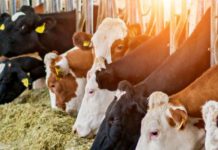
Antibiotic resistant infections, such as Methicillin-resistant Staphylococcus aureus, or MRSA, are becoming more dangerous because fewer drugs are effective against them. At least two million people per year are infected with antibiotic-resistant bacteria, and 23,000 people die each year as a result of reduced efficacy of the drugs, according to the Centers for Disease Control and Prevention.
“Antibiotic resistance is becoming a bigger and bigger problem, both in kids and adults, so much so that some infections are becoming difficult, if not impossible to treat,” Dr. David Haslam, a pediatric infectious disease specialist at Cincinnati Children’s Hospital Medical Center, told CBS News.
Roughly 80 percent of antimicrobial drugs sold in the United States in 2012 were for use on animals, and 60 percent of the drugs given to animals are considered important for human treatments.
“Most of the use involves the addition of low doses of antimicrobial agents to the feed of healthy animals over prolonged periods to promote growth and increase feed efficiency or at a range of doses to prevent disease,” researchers wrote in the study, published in the journal Pediatrics. “These nontherapeutic uses contribute to resistance and create new health dangers for humans.”
The researchers found there were a total of 19,056 reported drug-resistant infections in 2013, 4,200 of which resulted in hospitalization and 80 in death. The highest incidence of these infections was found in children under age 5.
Although the Food and Drug Administration, Congress and President Barack Obamahave attempted moves aimed to reduce antibiotic use among animals, legislation on the matter has been slow.
At least one reason farmers and corporations are slow to remove antibiotics from feed, said Dr. Jerome Paulson, former chairman of the Association of American Pediatrics Council on Environmental Health Executive Committee, because they save money as animals that get fatter faster can be sold even more quickly, taking up less space and eating less.
“The message is to change the practice of agribusiness, either through government changes or marketplace changes, so everybody is safer,” Paulson added. “I think if people vote with their pocketbooks, then industry will be required to change. Hopefully the USDA and the FDA will require them to change. I think this is something that with a large enough movement in society, the industry will be forced to change.”





